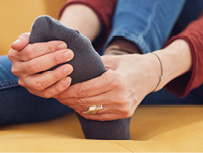The symptoms are neuropathy range from sharp, shooting pains that feel like jolts of electricity to burning sensations, tingling, numbness, and muscle fatigue. They can be mild and annoying or debilitating. If you’d describe your symptoms as uncomfortable and annoying—but not debilitating—you might want to start with nondrug treatments. They probably won’t eliminate the discomfort altogether, but they can make it easier to tolerate. If you decide to use medication, these treatments may enable you to take it for a shorter time and/or at a lower dose. Try one or more of the following at a time.
Vibrating foot-bath
Soaking your feet in a warm water vibrating footbath (available in department stores, pharmacies and online) for 15 to 20 minutes dilates blood vessels and increases circulation. The vibrations are detected and transmitted by large-diameter sensory nerve fibers that transmit signals very quickly. The sensations of vibration reach the spinal cord before the pain signals from damaged nerves, which blunts the discomfort. The pain relief is temporary but reliable.
For discomfort in other parts of the body, you can get similar relief from a whirlpool bath or a pulsating showerhead. Important: Some people with neuropathy are unable to sense temperatures and can burn their feet in too-hot water. Test the temperature with your hand first (or have someone else test it).
Menthol cream
The smooth muscles in arterial walls are lined with receptors that react to menthol. When you rub an affected area with menthol cream (such as Bengay), the blood vessels dilate, create warmth and reduce discomfort. These creams can be used long term as needed.
Transcutaneous electrical nerve stimulation (TENS)
This therapy delivers low levels of electric current to the surface of the skin. It’s thought that the current stimulates nerves and sends signals to the brain that block the discomfort from damaged nerves. In 2010, a meta-analysis of TENS in patients with diabetic neuropathies found that the treatment led to a decrease in pain scores. Other studies, however, have shown little or no benefit.
Battery-powered TENS units cost about $30 for low-end models. The treatment is largely without side effects, and some people have good results. Treatments are typically done for 30 minutes at a time and can be repeated as needed throughout the day. Treatments should not be done on skin that is irritated. Start using TENS under the direction of a physical therapist so that he/she can suggest the appropriate settings and amount of time for treatment.
Percutaneous electrical nerve stimulation (PENS)
Percutaneous means that the electric current is delivered under the skin, using short needles. Studies have shown that the treatments, done in rehabilitation/physical therapy offices, decrease pain, improve sleep and may allow patients to use smaller doses of painkilling medication. After each treatment, the pain relief can potentially last for weeks or longer.
The treatments take about 30 minutes per session and are generally repeated three times a week. Most patients have little or no pain during the treatments.
PENS is not advised for those with pacemakers and should not be done on areas of irritated skin. The treatments might or might not be covered by insurance—be sure to ask.
Self-massage
Firmly rubbing and/or kneading the uncomfortable area is another way to block pain signals. You must use enough pressure to stimulate the big nerves that carry the pressure sensations. If you have a history of deep vein thrombosis, ask your doctor before massaging your legs. If these measures aren’t sufficient, talk to your doctor about medication options.


